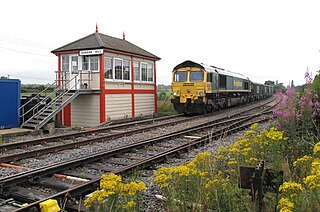
On a rail transport system, signalling control is the process by which control is exercised over train movements by way of railway signals and block systems to ensure that trains operate safely, over the correct route and to the proper timetable. Signalling control was originally exercised via a decentralised network of control points that were known by a variety of names including signal box, interlocking tower and signal cabin. Currently these decentralised systems are being consolidated into wide scale signalling centres or dispatch offices. Whatever the form, signalling control provides an interface between the human signal operator and the lineside signalling equipment. The technical apparatus used to control switches (points), signals and block systems is called interlocking.

Railway signalling (BE), or railroad signaling (AE), is a system used to control the movement of railway traffic. Trains move on fixed rails, making them uniquely susceptible to collision. This susceptibility is exacerbated by the enormous weight and inertia of a train, which makes it difficult to quickly stop when encountering an obstacle. In the UK, the Regulation of Railways Act 1889 introduced a series of requirements on matters such as the implementation of interlocked block signalling and other safety measures as a direct result of the Armagh rail disaster in that year.
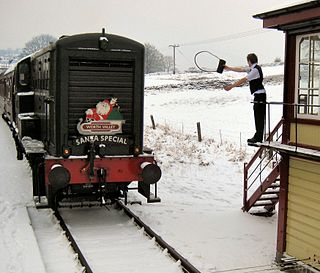
In railway signalling, a token is a physical object which a train driver is required to have or see before entering onto a particular section of single track. The token is clearly endorsed with the names of the section to which it belongs. A token system is more commonly used for single lines because of the greater risk of collision in the event of a mistake being made by a signaller or traincrew than on double lines.
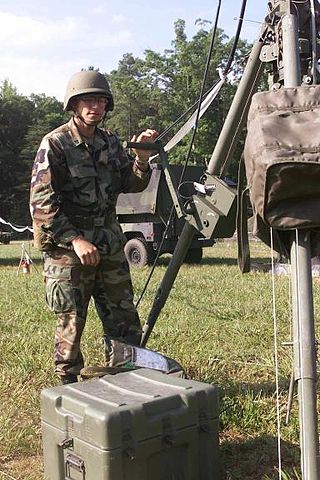
A signaller, signalman, colloquially referred to as a radioman or signaleer in the armed forces is a specialist soldier, sailor or airman responsible for military communications. Signallers, a.k.a. Combat Signallers or signalmen or women, are commonly employed as radio or telephone operators, relaying messages for field commanders at the front line, through a chain of command which includes field headquarters. Messages are transmitted and received via a communications infrastructure comprising fixed and mobile installations.
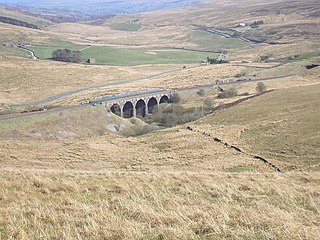
The Hawes Junction rail crash occurred at 5.49 am on 24 December 1910, just north of Lunds Viaduct between Hawes Junction and Aisgill on the Midland Railway's Settle and Carlisle main line in the North Riding of Yorkshire, England. It was caused when a busy signalman, Alfred Sutton, forgot about a pair of light engines waiting at his down (northbound) starting signal to return to their shed at Carlisle. They were still waiting there when the signalman set the road for the down Scotch express. When the signal cleared, the light engines set off in front of the express into the same block section. Since the light engines were travelling at low speed from a stand at Hawes Junction, and the following express was travelling at high speed, a collision was inevitable. The express caught the light engines just after Moorcock Tunnel near Aisgill summit in Mallerstang and was almost wholly derailed.

The Glenbrook rail accident occurred on 2 December 1999 at 8:22 am on a curve east of Glenbrook railway station on the CityRail network between Glenbrook and Lapstone, in the Blue Mountains of New South Wales, Australia. Seven passengers were killed and 51 passengers were taken to hospital with injuries when a CityRail electric interurban train collided with the rear wagon of the long-haul Perth-to-Sydney Indian Pacific.
The railway block signalling bell code is a system of bell sounds used in Great Britain to communicate between manually operated Signal Boxes in implementing the railway block system. Each such signal box has a bell circuit to the boxes on either side of it along the line. The equipment consists of a plunger or tapper which when pressed, rings a single-stroke bell in a neighbouring box. That box similarly has a tapper for communicating back, so boxes have keys each of which rings the bell in a neighbouring box. The bells sound different tones, so that the signalman can tell them apart by ear.
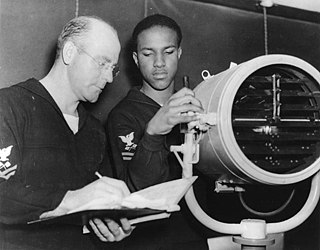
A signal lamp is a visual signaling device for optical communication by flashes of a lamp, typically using Morse code. The idea of flashing dots and dashes from a lantern was first put into practice by Captain Philip Howard Colomb, of the Royal Navy, in 1867. Colomb's design used limelight for illumination, and his original code was not the same as Morse code. During World War I, German signalers used optical Morse transmitters called Blinkgerät, with a range of up to 8 km (5 miles) at night, using red filters for undetected communications.

Absolute block signalling is a British signalling block system designed to ensure the safe operation of a railway by allowing only one train to occupy a defined section of track (block) at a time. Each block section is manually controlled by a signalman, who communicates with the other block sections via telegraph. This system was used on double or multiple lines where use of each line is assigned a direction of travel before the introduction of track circuits, and is still used on many lines to this day.

Signalman is a supervillain appearing in American comic books published by DC Comics. He is a member of Batman's rogues gallery.

"The Signal-Man" is a horror mystery story by Charles Dickens, first published as part of the Mugby Junction collection in the 1866 Christmas edition of All the Year Round. The story is told from a fictional first-person perspective.

In railway signalling, a treadle is a mechanical or electrical device that detects that a train wheel has passed a particular location. They are used where a track circuit requires reinforcing with additional information about a train's location, such as around an automatic level crossing, or in an annunciator circuit, which sounds a warning that a train has passed an exact point. They also serve as a critical backup in the case of track circuit failure. The important difference between a treadle and a track circuit is that while a track circuit detects a train over a distance as long as several kilometres, a treadle provides detection at a single fixed location.

Mechanical railway signalling installations rely on lever frames for their operation to interlock the signals, track locks and points to allow the safe operation of trains in the area the signals control. Usually located in the signal box, the levers are operated either by the signalman or the pointsman.

A signalman or signaller is an employee of a railway transport network who operates the points and signals from a signal box in order to control the movement of trains.
The Wrawby Junction rail crash was a train crash which occurred on 9 December 1983, at Wrawby Junction, near Barnetby station, North Lincolnshire, England.
Tryvandshøiden was a planned station on the Holmenkollen Line in Oslo, Norway. It was planned by the company Tryvandsbanen in the early 1910s and partly constructed in 1916 at the end of a single-tracked line from Frognerseteren. A red signalman's house named "Norden" was the station's only facility. Passenger trains never served the station, and the tracks from Frognerseteren to Tryvandshøiden were removed in 1939. The signalman's house was not demolished. In 1993, 2004 and 2008, proposals were made to re-open the station so that it would be more convenient for Oslo residents to use the Tryvann Ski Resort. However, these proposals were all rejected by the operator Oslo Sporveier on the grounds that the extension would be too expensive.
The Tamworth rail crash was an accident that happened at Tamworth railway station in Staffordshire, England, on 14 September 1870. It was caused when a signalman's error accidentally diverted the Irish Mail express onto a dead end siding, where part of the train crashed through the buffers and into the River Anker. Three people were killed, and thirteen injured.

On 17 April 1948, 24 people died when the 17:40 Glasgow to London Euston train hauled by LMS Princess Royal Class 4-6-2 No 6207 Princess Arthur of Connaught was stopped after the communication cord was pulled by a passenger. The stopped train was then run into by a following postal express hauled by LMS Coronation Class 4-6-2 No 6251 City of Nottingham.

On the evening of 26 December 1962, cold weather and snow in and around Crewe had caused points to become frozen and trains were being detained at signals. About midway between Winsford and Crewe, the 13:30 Glasgow Central to London Euston Mid-Day Scot, hauled by an English Electric type 4 diesel, D215, with 13 coaches and 500 passengers, was stopped at a signal but the driver found the telephone to Coppenhall Junction, the next signal box ahead, out of order. Seeing the next signal ahead he decided to proceed down towards it and use the telephone there, but too fast. In the darkness he failed to notice the 16:45 express from Liverpool Lime Street to Birmingham New Street, hauled by an electric locomotive with eight coaches with 300 passengers, standing on the line ahead and collided with it at about 20 mph (32 km/h).















